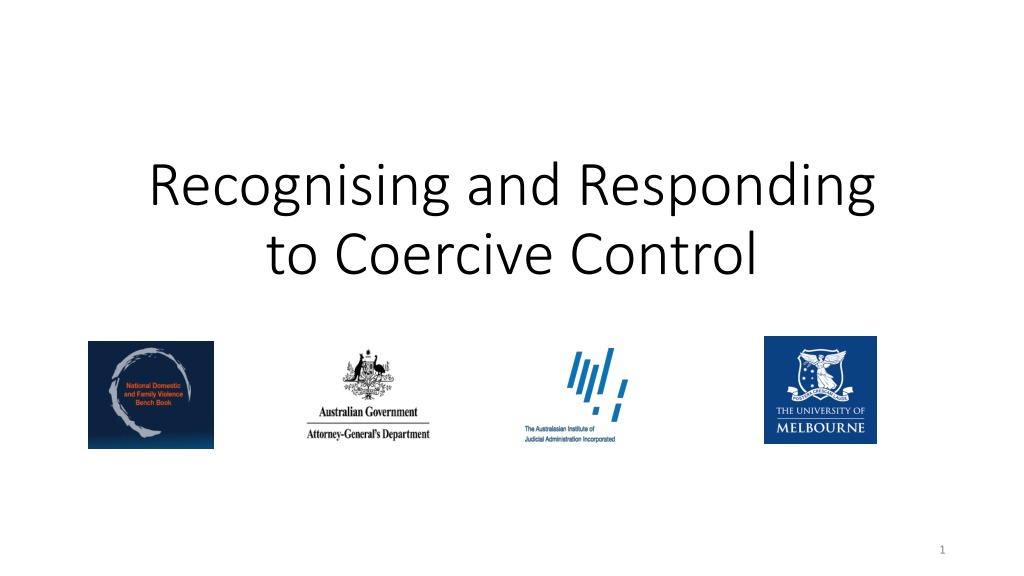Understanding Coercive Control in Relationships
Coercive control is a pattern of behavior used to dominate and control an individual, often seen in intimate partner relationships but can occur in other family dynamics. It is crucial to recognize the subtle signs of coercive control, such as financial restrictions, isolation, threats, and monitoring. Behaviors like belittling, threatening suicide, or using children to manipulate are common indicators. Awareness of cultural differences is vital in identifying and responding to coercive control effectively.
Download Presentation

Please find below an Image/Link to download the presentation.
The content on the website is provided AS IS for your information and personal use only. It may not be sold, licensed, or shared on other websites without obtaining consent from the author. Download presentation by click this link. If you encounter any issues during the download, it is possible that the publisher has removed the file from their server.
E N D
Presentation Transcript
Recognising and Responding to Coercive Control 1
What is coercive control? a course of conduct aimed at dominating and controlling another usually an intimate partner, but it may be present in other family or carer relationships mostly, but not always, perpetrated by men against women https://dfvbenchbook.aija.org.au/ section 3.2 Coercive control 2
Its a tricky thing to identify sometimes. A simple thing like he wouldn t let me have the money and I was stuck [might indicate coercive control]. Don t just look for the big hitters, the shouters Magistrates need to understand the subtlety of the abuse. The physical abuse might have happened years ago but that has set up the pattern of domination, now look for the subtle things. [coercive control] can be equally as dangerous as the big hitters. Coercive control is often subtle subtle. (Magistrate) 3
Coercive control look for patterns patterns of behaviour Individually behaviours can be easily explained but together its coercive control. (Magistrate) 4
What kinds of kinds of behaviours behaviours might indicate coercive control? Conduct which belittles and humiliates Use of animals, including direct threats of violence to animals or threats to keep animals from victim/survivors Limitations on liberty, movement and social interactions (isolation) Threats to commit suicide Rigid rule-making Vengeful use of authorities Monitoring, surveillance eg via technology 5
Threats in relation to children are common aspects of coercive control. For example, the abusive parent may threaten: to deprive the victim/survivor of contact with the children of the relationship to report her to child protection services and the victim/survivor will be exposed as a bad parent if the victim/survivor tells anyone about the abuse. Coercive control and children children 6
Coercive control cultural cultural differences differences Coercive control may be used differently in different communities. Extended family Religious pressures Cultural expectations may play a more important role in some communities than others. 7
Intimidating the victim/survivor, causing fear Isolation Jealousy Monitoring Attacks on self-confidence Loss of autonomy Economic abuse Intense affection followed by removal of intense affection, Offender justifying abusive behaviour Illicit drugs/substance use The red flags red flags for coercive control during during the relationship relationship 8
The time just before separation and soon after is a time of heightened risk. Threats (to kill the victim/survivor of abuse, children, extended family, pets, suicide or self- harm) Strangulation/hands on the throat Harassing Monitoring Disputes about children s matters Victim/survivor downplays or normalises abuse Attempts to control court hearings The red flags red flags for coercive control after after separation separation 9
Perpetrators may use the legal system as a tactic of coercive control. Sometimes called legal systems abuse Perpetrators may: make multiple applications and complaints in multiple courts make cross-applications for protection orders try to delay proceedings seeking multiple adjournments subpoena the victim/survivor s family and friends as witnesses delay or refuse to make financial disclosure seek to have matters heard separately conflict out lawyers The red flags red flags for coercive control after after separation separation. 10
Victim/survivors may: be framed as perpetrators present with a normalised response to abuse support their abusive partner s bail application retract statements side with their abuser rather than their children stay in a relationship because of coercive control Victim/survivors Victim/survivors responses responses to coercive control are complex. 11
Telling perpetrators who attempt to blame the victim/survivor that the consequences of their behaviour is no one s fault but their own. Where there is coercive control, refuse to entertain submissions of defence counsel in pleas in mitigation that a family violence perpetrator has an anger management problem or lost their temper. Call out descriptions of abusive relationships as toxic , volatile relationships. Be aware that apparently trivial breaches may indicate high risk. Call out attempts to exert inappropriate behaviour in the court environment. How do you address coercive control in the court room/process? 12
Be mindful of the effects of trauma on giving evidence. Be mindful of physical aspects of court surrounds which can improve safety for those participating in court processes. Call on security to reduce risk of breaches and other inappropriate behaviour in waiting areas. Take care not to collude with people who you find are abusive. Tailor protection orders to address particular coercive and controlling elements of individual relationships. Encourage parties to seek (independent) legal advice. Consider asking a suspected victim/survivor if they can decide now or whether they need more time (re: consent orders). How do you address coercive control in the court room/process? 13
More information: See the National Domestic and Family Violence Bench Book https://dfvbenchbook.aija.org.au/ Especially: section 3.2 Coercive control 14























